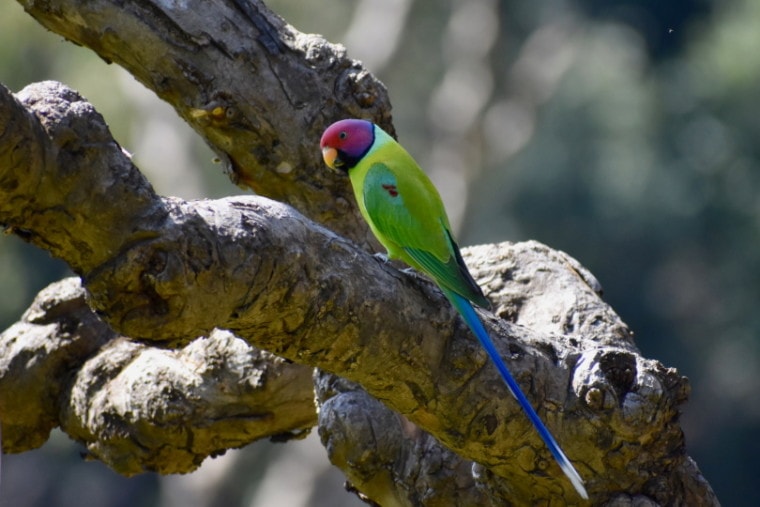
Click to Skip Ahead
The plum-headed parakeet is a beautiful bird characterized by bright colors, specifically the purple-red plumage on its head. These birds are affectionate and playful creatures that often make great companions. Keep reading our care guide to learn more about these birds and determine whether they are a good fit for you and your family.
Species Overview
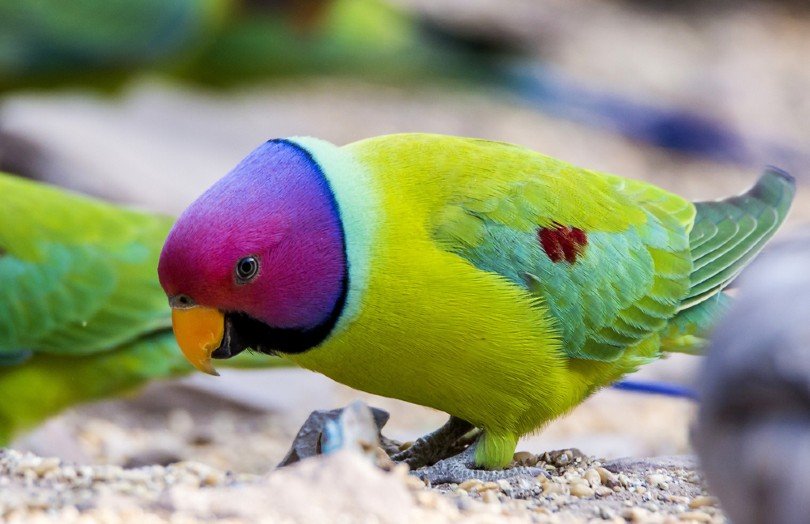
| Common Names | Plum-headed parrot, plum-headed parakeet |
| Scientific Name | Psittacula cyanocephala |
| Adult Size | Up to 12 inches |
| Life Expectancy | 20-30 years |
Origin and History
The plum-headed parakeet is native to the continent of Asia and is most commonly found in Sri Lanka, Bangladesh, India, and Pakistan. Their primary habitat is the forested areas or woodlands of these countries. Like other bird species around the world, the plum-headed parakeet has suffered some habitat loss, but this species is not currently considered to be endangered. The plum-headed parakeet is sometimes mistaken for the blossom-headed parakeet, also a member of the Psittacula family. It is thought that the intermediate parakeet, or Rothschild’s parakeet, is a hybrid between the plum-headed parakeet and the blossom-headed parakeet.
Temperament
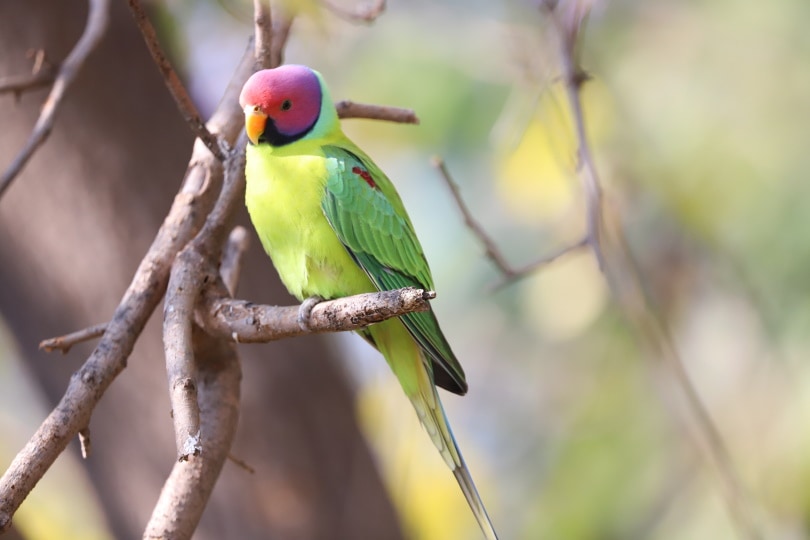
The plum-headed parakeet is known to be an affectionate, social, and docile bird. In comparison to other parrot breeds, they tend to be fairly quiet, which means that this bird could be a good option for apartment dwellers or others living in close quarters with their neighbors. One thing you should note is that while these birds tend to be friendly with their families, they can be a bit shy or even stand-offish with strangers.
If you have other birds, the plum-headed parakeet could be a good fit for your family. They tend to get along with other birds better than many parrot species and are even sometimes known to be protective over smaller birds.
Overall, the plum-headed parakeet requires less time from its owner than many other parrot species, but that doesn’t mean you can leave it to its own devices all the time. Like other parrots, the plum-headed parakeet is social in nature and thrives off of interactions with its human companion.
Speech & Vocalizations
If you are looking for a bird that can mimic human voices and words, the plum-headed parakeet could be a good choice. They are known for being good at picking up on human words, especially if their owners are diligent about talking to their parakeet regularly. It’s important to note that even if your parrot can pick up on words, they will not be able to pick up on the meaning unless you teach it to them.
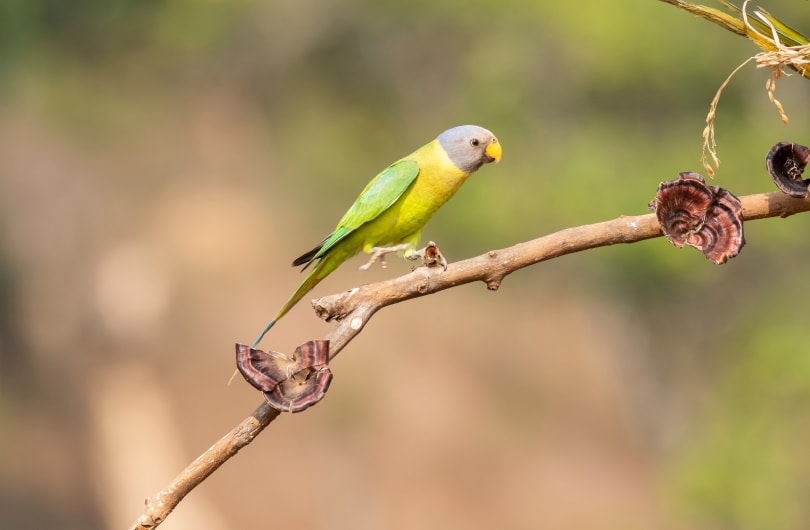
Plum-Headed Parakeet Colors and Markings
The plum-headed parakeet is distinguishable by bright, beautiful colors. Both male and female plum-headed parakeets have a mostly green body, though you will find shades of yellow-green and blue on their necks, abdomens, and tails. It’s fairly easy to tell male and female plum-headed parakeets apart because this is considered to be a dimorphic species. Males are characterized by their reddish-purple-colored heads, which give the species its name, as well as a ring of black around the neck that looks like a collar. Females, on the other hand, tend to have blueish-gray heads. Both males and females have bright yellow-orange beaks and black eyes.
Caring for the Plum-Headed Parakeet
The plum-headed parakeet requires a fairly large cage relative to other parrot breeds. At a minimum, the cage should be 24” L x 36 “ W x 36” H. Your plum-headed parakeet should be able to sit comfortably in the cage without touching any of the sides. When setting up your bird’s cage, make sure to include several different perches as well as bird toys. Parakeets and other parrot species love to chew on things; this is how they explore the world around them, both in nature and in captivity. Make sure at least some of the toys you provide are made for chewing.
In addition to providing your bird with perches and toys, you will need to include food and water bowls. Avoiding placing the food and water bowls underneath any of the perches in the cage; otherwise, your bird’s droppings could contaminate its food supply. You can buy bird food and water bowls that are made to attach to the side of the cage so that they do not need to sit on the cage floor. Plan to spot clean your parakeet’s cage on a daily basis. You can clean it in its entirety about once a month.
Common Health Problems
In general, the plum-headed parakeet is a fairly healthy and hardy bird. However, you should be aware of signs of illness in your bird so that you can address it if necessary. A sick bird may have dull, unfocused eyes, rumpled or missing feathers, or discharge coming from its eyes, nose, or mouth. If you think your parakeet may be ill, pay attention to your bird’s breathing, eating, and drinking habits. Does its breathing appear more belabored? Is it eating less than usual? If the answer is yes, it is probably time to take your parakeet to the vet for a checkup.
Below are some common health problems your plum-headed parakeet may be prone to developing:
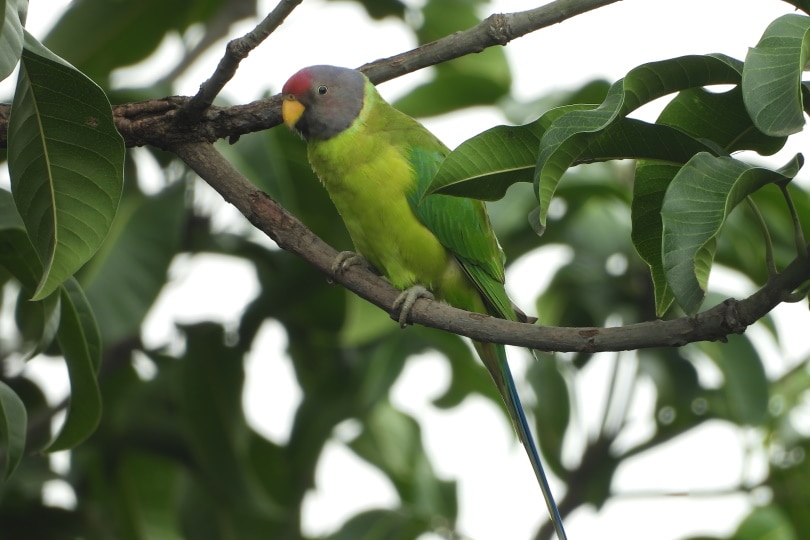
Diet and Nutrition
Wild parakeets tend to eat primarily seeds and fruits. In captivity, you should plan on feeding your bird a quality pellet and seed mix that is formulated for parakeets. This way, you can make sure that your bird’s nutritional needs are satisfied. You don’t need to portion out your bird’s food; it will generally eat when it is hungry and stop when it’s full. You can expect your parakeet to eat around a tablespoon of food per day.
In addition to the pellet and seed mix, you can give your parakeet plenty of fresh fruits, lightly cooked vegetables, and grains such as millet as snacks. Be sure you understand which foods are not good for your parakeet to eat. Fruits and vegetables you should avoid include rhubarb, apple seeds, pear seeds, avocados, stone fruit pits.
Exercise
You may not think about exercising your plum-headed parakeet the way you would set aside time to take a dog out for a walk, but plenty of exercise outside of the cage is essential for these birds. At a minimum, plan to take your bird out of its cage for at least 2-3 hours per day. You can purchase play gyms made specifically for birds to keep your parakeet busy. It will also enjoy playing games with you.
Where to Adopt or Buy a Plum-Headed Parakeet
If you’re interested in one of these birds, you can start by looking for one at your local animal shelter or bird sanctuary. You can also search online for birds in your area using services such as Petfinder. Adopting is not only cheaper than buying from a breeder, but it is also potentially kinder. Many bird owners, unfortunately, give up their birds when they realize how much work they can be, leaving these animals without a good home. You may find an older bird in a shelter or bird sanctuary, but remember that these animals can live to be 20 or even 30 years old. A 10-year-old parakeet still has a lot of life to live, and by adopting it, you are giving it another chance at a good life.
However, if you are set on getting a plum-headed parakeet but strike out in shelters, you will most likely need to go the route of finding a breeder. If you end up going this route, you will need to plan on spending somewhere between $400 and $700. When you are looking for a breeder, make sure to do your homework; not everybody in the pet market operates in the best interest of the animals. Don’t be afraid to ask plenty of questions. A good breeder should let you tour their breeding facilities.
Conclusion
There are many benefits to bringing home a plum-headed parakeet. They are social creatures that will provide you with cheerful company on a regular basis. However, these birds aren’t for everyone. For one thing, they are a long-term commitment. If you aren’t ready to commit to a pet for the next 20-30 years, you may want to reconsider. They also require a fair amount of attention and upkeep; if you don’t take time to socialize with your bird regularly, it may become withdrawn. Discuss these factors with your family before making the decision to buy a plum-headed parakeet. If you decide this bird is for you, you won’t regret making the addition to your family.
See also:
- Types of Red Parrots (With Pictures)
- Pet Insurance for Birds: Everything You Need to Know
- How to Choose the Right Pet Bird Food: Nutrition, Labels & More!
Featured Image Credit: Kat Aoki, Shutterstock








